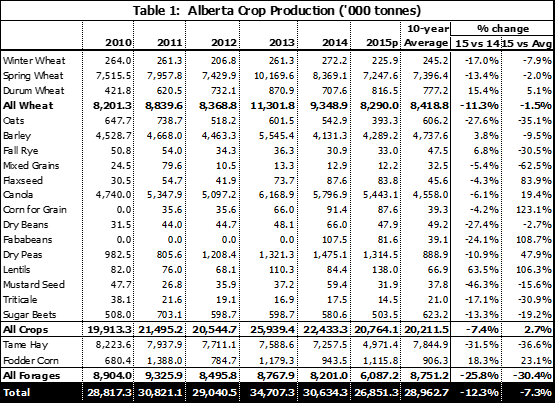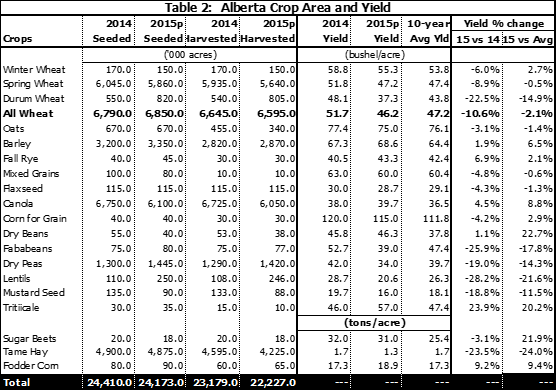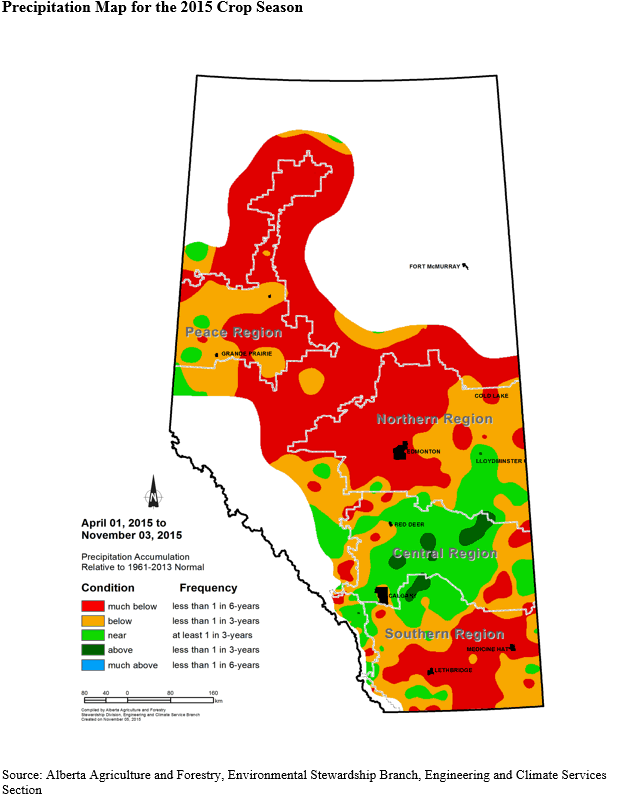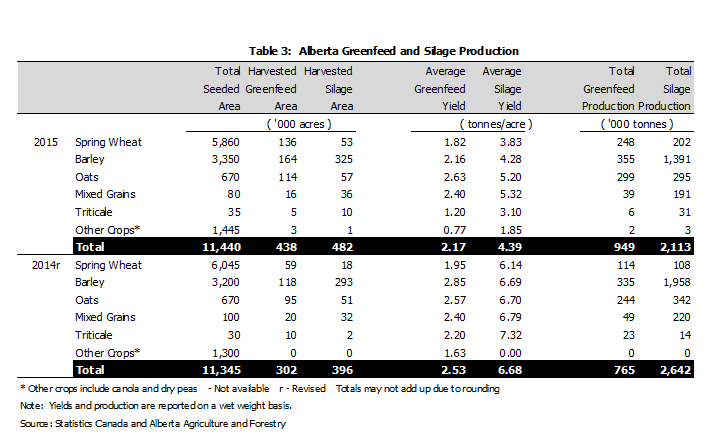| |

The 2015 crop season | Insects and crop diseases | Forage and pasture | Alberta crop production, 2015 | Alberta forage production, 2015 | Alberta crop production tables | Precipitation map
.
Overview
This report presents a review of the crop season in Alberta and an analysis of crop production statistics for 2015. In addition, a precipitation map for the 2015 crop season is attached for reference.
The 2015 Crop Season
Crop growing conditions in the province during 2015 were somewhat challenging for Alberta`s producers. The 2015 crop season started with a dry spring followed by a hot summer with limited moisture, which had an adverse impact on crop growth. However, as harvest progressed across the province yields were higher than what were expected. Alberta`s 2015 total field crop production (excluding forage) was comparable in volume to the non-drought years of 2008, 2010 and 2012.
The early snow melt in May allowed producers to get an early start to seeding across the province. Seeding progressed quickly compared to the 5-year average, particularly in the South Region, followed by the Central, North West, North East and Peace Regions. Fall seeded crops survived the winter with 77 per cent rated as good to excellent and 23 per cent rated as fair to poor. Surface soil moisture condition in the beginning of May was reported as 70 per cent excellent, 24 per cent fair and six per cent poor, but windy conditions depleted soil moisture levels during the month in the top couple of inches of the soil layer. Declining soil moisture caused some producers to delay seeding of shallow seeded crops, especially canola. Dry weather continued to persist across the South and Central Regions and delayed the seeding of canola. By the last week of May, surface soil moisture conditions dropped, with only 31 per cent rated as good to excellent province wide.
By the end of May, seeding was practically completed across the province, one week earlier than the 5-year average. However, extremely dry conditions and cool nights delayed seed emergence. Also, low night time temperatures in May caused some producers to re-seed, due to frost in their fields.
In June, dry weather continued throughout the province, exacerbated by warm temperatures and wind, which led to uneven crop emergence in annual crops. By mid-June, most areas of the province that were in critical need of moisture had received some spotty precipitation that caused uneven germination in late seeded crops, especially canola. By the end of June, isolated rain showers somewhat alleviated moisture stress. However, surface and sub-surface soil moisture conditions remained poor and field crops continued to be influenced by the dry conditions. Surface soil moisture conditions were reported as 21 per cent good to excellent, 36 per cent fair and 43 per cent poor as of June 29, 2015.
In July, temperatures returned to more normal levels and spotty showers were active in all regions, especially in Southern Region. However, dry conditions continued to persist in the Northern Region. Crop development and moisture ratings varied across the province by mid-July and continued to be influenced by dry weather. In the third week of July, precipitation in most parts of the province alleviated moisture stress on cereals and oilseeds crops. Surface and subsurface soil moisture ratings improved. However, soil moisture conditions remained extremely low through many areas, especially north of Edmonton and in much of the northern and eastern Peace Region. By the end of July, more moderate temperatures combined with widespread shower activities across the province decreased the stress on crops and improved both surface and sub-surface soil moisture.
August started with the return of above normal temperatures combined with limited precipitation, particularly in the more northerly regions. As a result of higher temperatures, crop development progressed quickly, with harvest almost one week ahead in August 2015 compared to most years. Harvest of winter cereals, field peas and barley started in the first week of August, while canola development was in a wide variance of crop stages across the province. Preliminary estimates of yield were reported as being low (25 to 30 per cent below average) for most crops. Surface and sub-surface soil moisture remained in poor condition until mid-August, when large parts of the province received 5 to 70 mm of precipitation. Rain showers continued until the end of August, with rainfall accumulation causing some delays in harvest operations. Improvement in both surface and sub-surface provincial soil moisture benefited late seeded crops. While yield estimates improved significantly by the end of August, second growth became a significant problem for producers.
Harvest operation in September was another challenge for producers. The month started with thick smoke haze in the atmosphere which reduced temperatures and slowed drying across much of the province. While windy conditions in Southern Alberta helped to dry crops, it caused damage by blowing swaths and breaking heads. By mid-September, harvest progress was ahead in the Southern, North East and North West Regions (compared to 2014), and five per cent more advanced provincially. However, generally damp conditions in September delayed harvest operations across the province. By the end of September, harvest was behind in all regions and 26 per cent provincially, compared to 2014. September rainfall was beneficial for fall seeded crops and improved soil moisture, especially in the Southern, Central and North East Regions.
Dry and warm weather in October allowed producers to complete harvest by the end of October. Overall, crop yields in the province in 2015 were a little below their long term averages, but much better than was expected earlier in the summer. Crop quality dropped after the wet rainy weather in September slowed harvest progress, largely because of sprouting in many crops. However, crop quality was still above the long-term average for all crops, except for malt barley, oats and canola.
Insects and Crop Diseases
In 2015, poor growing conditions led to some insect issues. This was especially true with flea beetles and cutworms in canola. Grasshoppers were a large concern in some areas in central Alberta and parts of the Peace Region. Wheat midge was not a major concern. The incidence of Bertha armyworm was extremely low throughout the province. Pea leaf weevil was a concern for fava bean producers in central Alberta.
Forage and Pasture
In May, pasture, hay and fall seeded crops started greening slowly. The dry conditions and cool nights causing slow growth for tame hay and pasture. Provincially, both hay and pasture growth conditions were reported as 25 per cent poor, 41 per cent fair, 31 per cent good, and three per cent excellent as of May 26, 2015. In June, grasses and legumes stopped growing and turned brown due to the dry condition. Both hay and pasture growth conditions deteriorated to only 17 per cent rated as good or excellent as of June 29, 2015. By mid-August, first cut dryland hay was 96 per cent complete, with an average provincial yield of 0.8 ton per acre. For irrigated haying operations, it was virtually complete with yield reported at 2.4 tons per acre. The quality of first cut hay was rated as 64 and 84 per cent good to excellent, respectively, for dryland and irrigated hay. Hay and pasture growth showed a slight improvement in August and was rated as 19 per cent good or excellent. Similarly, as of September 29, pasture growth conditions reported at 34 per cent poor, 37 per cent fair and 29 per cent good or excellent, across the province.
With respect to tame hay, production was down 31.5 per cent from 2014. The decline was attributed to a significant drop in yield and a decrease in harvested area. The drop in yield was mainly due to a dry spring with cool overnight temperatures followed by a hot summer with limited moisture. Pasture conditions remained poor and continued to show the effects of dry conditions during spring and early summer.
Alberta Crop Production, 2015
Total 2015 Crop Production
On December 4, 2015, Statistics Canada released its third and final estimates of crop production for Canada and provinces. Based on this report, total production of principal field crops (including forages) in Alberta was estimated at 26.9 million tonnes, down 12.3 per cent from 2014 (see Table 1). While crop production in 2015 was 2.7 per cent higher than the 10-year (2005-2014) average, forage production was 34.0 per cent below the 10-year average, resulting in a 7.3 per cent drop (from the 10-year average) in total production of crop and forage. Provincial average yields were generally lower than in 2014 (see Table 2) which was an above average year. Crop quality in general was about average. In 2015, total seeded and harvested areas of principal field crops in the province declined 0.6 per cent and 4.1 per cent, respectively.
2015 Production by Crop Type
Total production of spring wheat in 2015 decreased 13.4 per cent from 2014, to 7.2 million tonnes, and was 2.0 per cent lower than the 10-year average. The lower production stemmed from a decline in yield and harvested area. Yield was down 8.9 per cent, while harvested area declined 5.0 per cent from 2014. The provincial average yield was 47.2 bushels per acre and harvested area at 5.6 million acres. For durum wheat, production was up 15.4 per cent, to 816,500 tonnes. Durum production was 5.1 per cent higher than the 10-year average, due to an increase in harvested area of 49.1 per cent to 805,000 acres. Average yield fell 22.5 per cent to 37.3 bushels per acre. Overall, production of all wheat was 8.3 million tonnes, a decrease of 11.3 per cent from 2014.
Total barley production increased to 4.3 million tonnes, up 3.8 per cent from the previous year. The higher production was attributed to a 1.9 per cent increase in yield to 68.6 bushels per acre, and a 1.8 per cent increase in harvested area at 2.9 million acres. Despite this increase, barley production was 9.5 per cent below the 10-year average.
Total canola production decreased 6.1 per cent from last year to 5.4 million tonnes, but was 19.4 per cent higher than the 10-year average. The decrease was due to lower harvested area, down 10.0 per cent to 6.0 million acres. Canola yield in 2015 was 39.7 bushel per acre, up 4.5 per cent from 2014 and 8.8 per cent from the 10-year average.
Dry peas production fell 10.9 per cent to 1.3 million tonnes. Harvested area was up 10.1 per cent to 1.4 million acres, while yield fell 19.0 per cent to 34.0 bushels per acre.
Total oat production fell 27.6 per cent to 393,300 tonnes, and was 35.1 per cent below the 10-year average. The decline was attributed to a 25.3 per cent drop in harvested area, and yield falling by 3.1 per cent.
Tame hay production fell 31.5 per cent to 5.0 million tonnes, 36.6 per cent below the 10-year average. The decline was attributed to a significant drop in yield as well as a decrease in harvested area. The average yield declined 23.5 per cent to 1.3 tons per acre, while harvested area was down 8.1 per cent to 4.2 million acres.
2015 Crop Production, Canada
Total 2015 Canadian production was 20.0 million tonnes for spring wheat, 5.4 million tonnes for durum, 8.2 million tonnes for barley, 3.4 million tonnes for oats, 17.2 million tonnes for canola, and 3.2 million tonnes for dry peas.
Alberta Forage Production, 2015
Total tame hay production in Alberta in 2015 was estimated at 5.0 million tonnes, based on the Statistics Canada report “Production of Principal Field Crops, December, 2015”. This was down 31.5 per cent from 2014, and 36.6 per cent below the 10-year average. The decline in production was as a result of lower yields (down 23.5 per cent from last year), as well as a decrease in harvest area (down 8.1 per cent to 4.2 million acres).
Based on a survey conducted by the Statistics and Data Development Section of Alberta Agriculture and Rural Development, total greenfeed production in the province increased 24.0 per cent from 2014, to 949,000 tonnes (Table 3), mainly due to a 45.0 per cent increase in harvested area and despite a 14.2 per cent decrease in the average provincial yield. Total silage production was estimated at 2.1 million tonnes, down 20.0 per cent from 2014. This reduction was the result of a 34.3 per cent decline in the average provincial yields for silage which more than offset a 21.7 per cent increase in harvested area.
Challenging growing conditions during the 2015 crop season and low night temperatures in spring contributed to lower yields for both greenfeed and silage. The provincial average yield for greenfeed was estimated at 2.17 tonnes per acre, 14.2 per cent lower than in 2014. The estimated provincial average yield for silage declined 34.3 per cent to 4.39 tonnes per acre.
Total area harvested for greenfeed and silage in 2015 was estimated at 919,976 acres, an increase of 32 per cent from 2014 (See Figure 1). Total area harvested for greenfeed increased 45.0 per cent to 438,219 acres, while silage acreage rose by 21.7 per cent to 481,757 acres. Producers harvested more greenfeed and silage mainly because of a significant shortage in hay production caused by the dry conditions in the province.
Contacts
For additional information relating to this report, please do not hesitate to contact the author.
This report is also available on the Internet at:
http://www1.agric.gov.ab.ca/$department/deptdocs.nsf/all/sdd4191
Alberta Agriculture and Rural Development
Economics and Competitiveness Division
Statistics and Data Development Branch
Ashan Shooshtarian
Crop Statistician
780-422-2887
Email: ashan.shooshtarian@gov.ab.ca
Alberta Crop Production Tables




 |
|